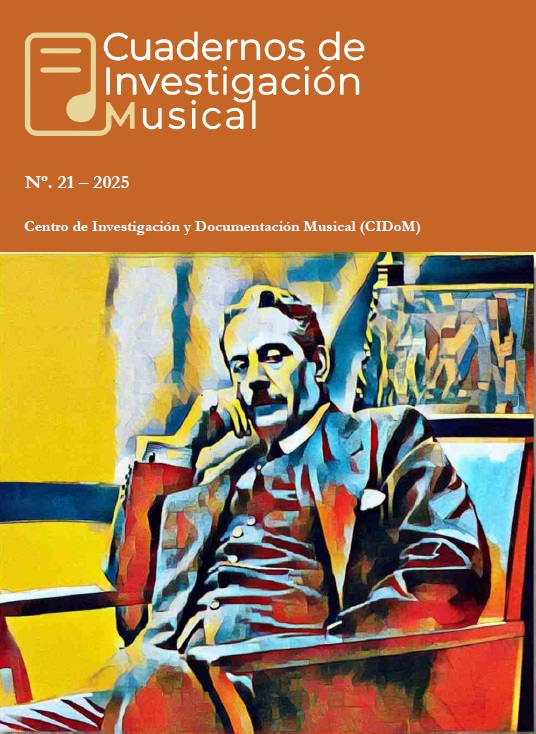Puccini sung by an excited penguin. Application of the MusScreen Method to Musical Education classrooms.
DOI:
https://doi.org/10.18239/invesmusic.2025.21.06Keywords:
Puccini, film music, MusScreen Method, musical didactics, audio-visualAbstract
Puccini’s music has served the audiovisual field profusely, in all its formats and variants. The expressive potential and gracefulness of their melodies have led to them being used recurrently, both to frame situations and to generate various dialectics between the sound and the visual in media. The main objective of this text is to propose possibilities of pedagogical action around Puccinian music inserted in the audiovisual, for which the observance of the MusScreen Method as a model that reflects a concrete example is highly significant. Methodologically, the four major strategies of the aforementioned didactic model are rescued to apply them to a scene from the animated feature film Happy Feet 2 (dir. Miller, 2011). The results are shown as examples that serve as an incentive for future approaches that may be based on other audiovisual productions.
References
Adams, C. R. (2023). Staging the Cinematic: Puccini, Fanciulla, and Early Silent Film. Journal of the American Musicological Society, 76(1), 1–55. https://doi.org/10.1525/jams.2023.76.1.1
Bennett, K. C. (2004). The Gender Politics of Death: Three Formulations of ‘La Bohème’ in Contemporary Cinema. Journal of Popular Film and Television, 32(3), 110–120. https://doi.org/10.1080/01956051.2004.10662056
Bernabé Villodre, M. M., Bermell Corral, M. Á. & Alonso Brull, V. (2015). La optimización de la atención a través de la música cinematográfica: prácticas en Educación Secundaria Obligatoria. Educatio Siglo XXI, 33(2), 261–280. https://doi.org/10.6018/j/233241
Citron, M. J. (2011). The Operatics of Detachment: Tosca in the James Bond Film ‘Quantum of Solace’ . 19th-Century Music, 34(3), 316–340. https://doi.org/10.1525/ncm.2011.34.3.316
Davis, A. (2010). Il Trittico, Turandot, and Puccini's Late Style. Indiana University Press.
Ethnersson Pontara, J., (2024). ‘You Want Drama? Go to the Opera!’: Opera as a Means of Negotiation between Fiction and Real Life in Mission: Impossible – Rogue Nation. Music, Sound, and the Moving Image, 18(1), 7-27. https://doi.org/10.3828/msmi.2024.3
Goldberg, S. H. (2018). Sliding Walls and Glimpses Of The Other In Puccini’s ‘Madama Butterfly’. The Psychoanalytic Quarterly, 87(3), 479–495. https://doi.org/10.1080/00332828.2018.1495518
Houlahan, M. & Tacka, P. (2015). Kodály today. A Cognitive Approach to Elementary Music Education. Oxford University Press.
Larson, K. R. (2009). Silly Love Songs: The Impact of Puccini's La Bohème on the Intertextual Strategies of Moulin Rouge!. The Journal of Popular Culture, 42(6), 1040-1052. https://doi.org/10.1111/j.1540-5931.2009.00721.x
Lockhart, E. (2011). Photo-Opera: La fanciulla del West and the staging souvenir. Cambridge Opera Journal, 23(3), 145-166. https://doi.org/10.1017/S0954586712000080
López Melgarejo, A. M., López Núñez, N. & de Moya Martínez, M. V. (2023). Musication: un recurso TIC para docentes de música. Ensayos. Revista de la Facultad de Educación de Albacete, 38(1), 63–79. https://doi.org/10.18239/ensayos.v38i1.3254
López Núñez, N. & López Melgarejo, A. M. (2023). La figura del director de orquesta en ‘Mozart in the jungle’: realidad o ficción. Quaderns de cine, 19, 39-46. https://rua.ua.es/dspace/bitstream/10045/138785/1/Quaderns-de-Cine_19_04.pdf
Mag Uidhir, C. (2013). Introduction: Art, Metaphysics, and the Paradox of Standards. In C. Mag Uidhir (Ed.), Art and Abstract Objects (pp. 1-28). Oxford University Press.
Martín Félez, D. & Martínez Noguera , E. M. (2022). Educación emocional y musical a través de la película ‘Coco’ (2017) de Disney-Pixar. Propuesta didáctica necesaria en tiempos de pandemia. Popular Music Research Today: Revista Online de Divulgación Musicológica, 4(1), 117–142. https://doi.org/10.14201/pmrt.28356
Montoya Rubio, J. C. (2022). El Método MusScreen. Didáctica de la expresión musical a través del audiovisual. Indepently Published.
Olarte Martínez, M., Montoya Rubio, J. C., Martín Félez, D. & Mosquera Fernández, A. (2011). La incorporación de los medios audiovisuales en la enseñanza de la música. Revista Docencia e investigación, 21, 151-168. https://gredos.usal.es/bitstream/handle/10366/154561/montoya_olarte2011docenciainvestigacion.pdf?sequence=1&isAllowed=y
Robles Sánchez, J. (2023). Los instrumentos musicales en el Método MusScreen. Revista InstrumentUM, 3, 40-54. https://instrumentum.es/wp-content/uploads/2023/11/LOS-INSTRUMENTOS-MUSICALES-EN-EL-ME%CC%81TODO-MUSSCREEN-InstrumentUM-2023.pdf
Sacristán-Ramírez, C., Everaldo, F. O., Burguete, Y. & De Man, B. (2023). Al in Music: Implications and Consequences of Technology Supporting Creativity. In M. Cebral-Loureda, E. G. Rincón Flores, & G. Sánchez-Ante (Eds.), What AI Can Do Strengths and Limitations of Artificial Intelligence (pp. 233-253). https://doi.org/10.1201/b23345-15
Scassillo, F. (2019). ‘Si rinasce, ancor sento la vita qui...’. Mood, atmosférico e atmosfera nell’opera lirica: due scene di morte a confronto. Studi di Stetica, 14, 255-279. https://doi.org/10.7413/18258646093
Sheppard, W. A. (2005). Cinematic realism, reflexivity and the American ‘Madame Butterfly’ narratives. Cambridge Opera Journal, 17(1), 59-93. https://doi.org/10.1017/S0954586705001941
Velázquez Aguilar, A., & Sánchez Ortega, P. (2015). La lectoescritura musical: métodos precursores. Varona. Revista científico-metodológica, 61, 1-11. https://www.redalyc.org/pdf/3606/360643422018.pdf
Wilson, A. (2013). Golden-Age Thinking: Updated Stagings of Gianni Schicchi and the Popular Historical Imagination. Cambridge Opera Journal, 25(2), 185-201. https://doi.org/10.1017/S0954586713000062
Published
Issue
Section
License
Copyright (c) 2025 Juan Carlos Montoya-Rubio

This work is licensed under a Creative Commons Attribution-NonCommercial-NoDerivatives 4.0 International License.
Los autores de los artículos mantienen el copyright, no recibirán ninguna contraprestación económica por el trabajo y el mismo siempre será reconocido como exclusivamente suyo. La revista se compromete a proteger la integridad y originalidad del artículo, así como los derechos de autor que correspondan. Los autores son los únicos responsables del material, textos e imágenes que utilizan en sus respectivos trabajos, debiendo respetar siempre los derechos de autor de terceras personas, por lo que la revista no se hace responsable de lo contenido en este tema respecto al trabajo de los autores.


